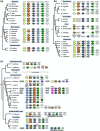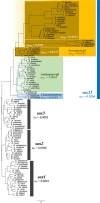Independent pseudogenizations and losses of sox15 during amniote diversification following asymmetric ohnolog evolution
- PMID: 34193037
- PMCID: PMC8244163
- DOI: 10.1186/s12862-021-01864-z
Independent pseudogenizations and losses of sox15 during amniote diversification following asymmetric ohnolog evolution
Abstract
Background: Four ohnologous genes (sox1, sox2, sox3, and sox15) were generated by two rounds of whole-genome duplication in a vertebrate ancestor. In eutherian mammals, Sox1, Sox2, and Sox3 participate in central nervous system (CNS) development. Sox15 has a function in skeletal muscle regeneration and has little functional overlap with the other three ohnologs. In contrast, the frog Xenopus laevis and zebrafish orthologs of sox15 as well as sox1-3 function in CNS development. We previously reported that Sox15 is involved in mouse placental development as neofunctionalization, but is pseudogenized in the marsupial opossum. These findings suggest that sox15 might have evolved with divergent gene fates during vertebrate evolution. However, knowledge concerning sox15 in other vertebrate lineages than therian mammals, anuran amphibians, and teleost fish is scarce. Our purpose in this study was to clarify the fate and molecular evolution of sox15 during vertebrate evolution.
Results: We searched for sox15 orthologs in all vertebrate classes from agnathans to mammals by significant sequence similarity and synteny analyses using vertebrate genome databases. Interestingly, sox15 was independently pseudogenized at least twice during diversification of the marsupial mammals. Moreover, we observed independent gene loss of sox15 at least twice during reptile evolution in squamates and crocodile-bird diversification. Codon-based phylogenetic tree and selective analyses revealed an increased dN/dS ratio for sox15 compared to the other three ohnologs during jawed vertebrate evolution.
Conclusions: The findings revealed an asymmetric evolution of sox15 among the four ohnologs during vertebrate evolution, which was supported by the increased dN/dS values in cartilaginous fishes, anuran amphibians, and amniotes. The increased dN/dS value of sox15 may have been caused mainly by relaxed selection. Notably, independent pseudogenizations and losses of sox15 were observed during marsupial and reptile evolution, respectively. Both might have been caused by strong relaxed selection. The drastic gene fates of sox15, including neofunctionalization and pseudogenizations/losses during amniote diversification, might be caused by a release from evolutionary constraints.
Keywords: 2R-WGD; Gene loss; Marsupial; Neofunctionalization; Ohnolog; Ortholog; Pseudogene; Relax; Reptile; d N/d S.
Conflict of interest statement
The authors declare no competing interests.
Figures




Similar articles
-
OHNOLOGS v2: a comprehensive resource for the genes retained from whole genome duplication in vertebrates.Nucleic Acids Res. 2020 Jan 8;48(D1):D724-D730. doi: 10.1093/nar/gkz909. Nucleic Acids Res. 2020. PMID: 31612943 Free PMC article.
-
Mammalian Sox15 gene: promoter analysis and implications for placental evolution.Zoolog Sci. 2008 Mar;25(3):313-20. doi: 10.2108/zsj.25.313. Zoolog Sci. 2008. PMID: 18393569
-
Function and molecular evolution of mammalian Sox15, a singleton in the SoxG group of transcription factors.Int J Biochem Cell Biol. 2010 Mar;42(3):449-52. doi: 10.1016/j.biocel.2009.10.023. Epub 2009 Nov 10. Int J Biochem Cell Biol. 2010. PMID: 19909824 Review.
-
Discovery of All Three Types in Cartilaginous Fishes Enables Phylogenetic Resolution of the Origins and Evolution of Interferons.Front Immunol. 2019 Jul 12;10:1558. doi: 10.3389/fimmu.2019.01558. eCollection 2019. Front Immunol. 2019. PMID: 31354716 Free PMC article.
-
The zebrafish genome in context: ohnologs gone missing.J Exp Zool B Mol Dev Evol. 2007 Sep 15;308(5):563-77. doi: 10.1002/jez.b.21137. J Exp Zool B Mol Dev Evol. 2007. PMID: 17068775 Review.
Cited by
-
Enigmatic Nodal and Lefty gene repertoire discrepancy: Latent evolutionary history revealed by vertebrate-wide phylogeny.Dev Dyn. 2025 Aug;254(8):887-901. doi: 10.1002/dvdy.710. Epub 2024 Apr 22. Dev Dyn. 2025. PMID: 38647085 Free PMC article. Review.
References
Publication types
MeSH terms
Associated data
LinkOut - more resources
Full Text Sources
Molecular Biology Databases
